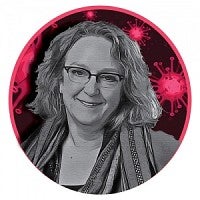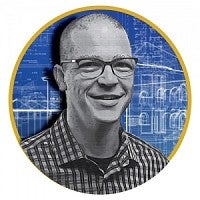The United States is moving toward reopening after months of pandemic shutdowns, and the UO is returning to in-person classes this fall. Businesses, schools and organizations are shifting back to normal operations as vaccination rates rise around the country. There is a growing sentiment that the pandemic is nearing an end.
So, Around the O is revisiting a story from a year ago, where UO experts weighed in on COVID-19 through the lens of their research expertise. Now they’re providing insights into what surprised them during the pandemic, what’s currently happening in their field and what they are watching as things reopen.
Tim Duy — economics

“It’s a very large departure from what has happened during other recessions,” he said.
But a thing that has played out as expected is the prediction that the economy could reopen once a vaccine was developed and distributed. Now that vaccines are widely available and vaccination rates are high, Duy said economic activity is resuming as predicted and consumers are eager to spend money.
“People are normalizing their behavior very quickly and spending money at a rapid pace,” he said.
But while economic activity is ramping back up, some components of the economy are still catching up from the pandemic shutdown, like supply chains, which got backlogged and are unable to keep pace with demand for goods. As a result, inflation rates are rising and Duy wonders how much of the current inflation will outlast the pandemic.
One thing he does expect to outlast the pandemic is an increased shift to remote work, which could have many ripple effects on the economy and labor market. Local economies in urban areas could struggle as workers stay home and don’t commute — or spend money — in downtown centers.
And the enhanced mobility of workers also means firms have to compete for labor on a national and international scale. And it means the local employment market is not so local anymore as employers are up against firms outside the region where they’re headquartered.
And then there’s the question of what workers want after experiencing the life benefits of working from home, like avoiding a commute.
“People have the potential to make a major life change and continue to work from home,” Duy said.
He expects many people to return to their pre-pandemic activities because “behavior is sticky,” but Duy is curious about what other individual practices may shift as economic activity resumes.
Ellen Peters — decision-making and science communication

“What we think we know is true about the pandemic keeps changing,” Peters said. “It’s such a novel disease that emerging science about it has changed what we do more than once. It’s a really unusual situation.”
That reality has presented a challenge for science communication, said Peters, who is also the director of the UO’s Center for Science Communication Research.
Some of the guidance from agencies during the pandemic has been issued with a great deal of certainty, but then something changes and that guidance is no longer true, like when health officials said masks wouldn’t be helpful during the early stages of the pandemic. They then found out more about the virus and did a reversal, recommending the use of masks to control its spread.
How the changes have been communicated has contributed to public confusion and mistrust of science, Peters said.
“There hasn’t been enough communication about the scientific process,” she said.
Moving forward, Peters sees an opportunity to increase awareness about the scientific process to help build more trust in science and combat misinformation.
“We need to increase the public’s scientific and numerical literacy and help them understand statistics in the news so that they can make informed decisions,” she said.
Some science issues have been more politicized than ever before, and she stresses that people need to be equipped with the tools that help them digest science-related news and make good personal choices. She recommends doing things like looking past an anecdote in a news story for the data that tells the larger story.
She also thinks it’s vital to encourage scientific curiosity, so people are more likely to explore and build knowledge themselves and less likely to believe and share misinformation.
Janis Weeks — biology and infectious diseases

“This coronavirus outbreak has been a tremendous wake-up call that emerging infectious diseases are an ever-increasing threat and that nations need to better prepare in advance,” Weeks said. “It's a question of ‘when,’ not ‘if,’ there will be future outbreaks of new pathogens.”
More research needs to be focused on emerging pathogens to help prepare for future outbreaks, she said.
“We don't know what kind of pathogen will cause the next big outbreak, but by developing modular vaccines which can be quickly developed and tested, we can respond more rapidly,” she said.
She also stresses that combating climate change is a vital part of reducing the risk of future outbreaks because things like habitat destruction and migration to urban centers can drive epidemics.
Weeks was surprised by the politicization of public health measures like masks and social distancing during the pandemic, but she was thrilled that effective vaccines were developed and tested in such a short amount of time.
“It's especially significant that the mRNA vaccines, which use a new molecular technology to produce antigens and evoke an immune response, were found to be safe and effective, in record time,” Weeks said.
Weeks stressed the importance of increasing global vaccination rates to help combat the viral mutations that can fuel the spread of disease,something that has been known to happen with many infectious diseases.
“Unvaccinated people provide petri dishes for the virus to try out new mutations,” Weeks explained. “Through natural selection, the more transmissible strains will win out. In the worst case, mutant SARS-CoV-2 strains could overcome the immunity from vaccination or past infection. So promoting global vaccination is both a social justice issue and an investment in our own safety. Now that vaccination rates in the U.S. are up, it's time to help other parts of the world.”
Kevin Van Den Wymelenberg — building design and human health

Van Den Wylmelenberg believes this lag in guidance prevented faster action to improve building ventilation systems. But he is now seeing developments with ventilation codes and building standards that are promising and would help mitigate disease transmission in shared spaces.
“We continue to pursue our dream of near-real-time viral monitoring indoors and we are working diligently on testing highly sensitive and rapid forms of detection for indoor pathogens, including SARS-CoV-2,” Van Den Wylmelenberg said. “We are also developing risk analysis methods so that buildings can be operated with awareness of risk and have appropriate strategies in place commensurate with pathogen transmission risks.”
Van Den Wylmelenberg expects to see a move to design and renovate buildings so they can make shared air spaces safer. That could happen through systems designed to transition between modes that could reduce pathogen transmission risk, remove outdoor particulate matter like wildfire smoke, and reduce energy consumption.
“Shared indoor air presents a risk for pathogen transmission, and COVID-19 has forced us to address this reality,” he said. “We know how to measure and mitigate indoor disease transmission risk, so the critical remaining question is: How will we manage this risk?”
“We are still chasing the vision for near-real-time pathogen monitoring indoors because we believe that it will help to guide effective and right-sized risk mitigation efforts, allow us to operate buildings with reduced energy consumption, and reopen with resilience and maintain a thriving economy,” he said.
—By Emily Halnon, University Communications


